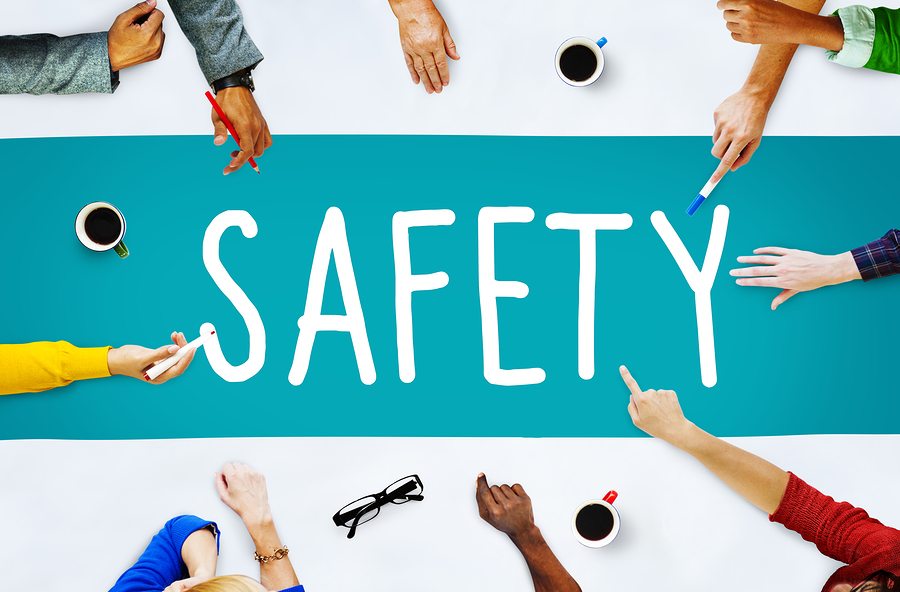by jeffp | Dec 28, 2015 | Workplace Safety

Learning first aid is something touted by everyone from safety experts to nurses and doctors as being of the utmost importance. Many of us say we will do it later or wonder how important it could really be to learn something as seemingly simple as first aid. However, knowing how to properly administer first aid to an injured individual can decrease the severity of their injuries and even potentially save their life.
A small cut, burn, bump to the head, or other minor injury may seem like a trivial event, but even the most minor injury can turn into a serious medical problem without the appropriate first aid measures. For example, a small cut can become infected, fester, and become very painful unless properly attended. Such injuries can even cause the person to miss work, which causes both employer and employee to lose valuable money and time.
Although usually done with the best intentions, individuals that haven’t received first aid training often make multiple mistakes as they try to help someone with an injury. Such mistakes can make the injury worse or even have deadly consequences for the injured person.
Let’s look at some of the most commonly offered bad advice and mistakes made by those untrained to deliver first aid:
1. Tilt your head back to stop your nose bleed.
A person with a bleeding nose should never lean or tilt their head back, as this can cause the blood to run into their throat and potentially cause them to choke on their own blood. Instead, the person should take a seated position, lean forward, and pinch their nose just underneath the sides of the nasal bone. This position should be held for five to ten minutes. The person shouldn’t blow or pick at their nose and they shouldn’t bend over for several hours after the nose bleed subsides. Nosebleeds that continue over 20 minutes require medical attention.
2. Failing to act quickly in emergency situations.
This is by far one of the most common first aid mistakes people make. Your response time to a co-worker suffering a laceration over an artery could mean the difference between him bleeding to death in a matter of minutes and having a story to tell his family about his co-worker saving his life.
You should act quickly and calmly to elevate the area above the person’s heart (if possible) and apply direct pressure over the wound. Keep in mind that even injuries not of such direness should have a speedy reaction. For example, an untreated minor scratch on a piece of rusty metal can cause some serious complications, such as tetanus or sepsis. You should wash minor scratches, scrapes, and cuts with either clean running water or an antiseptic solution, apply an antibiotic ointment, and cover the area with a sterile gauze dressing.
3. Move that badly injured person to safety.
Unless an injured person is in an immediate and severely life threatening situation, they should never be moved. And, severely life threatening means circumstances like being moments from being burned alive within their wrecked car. Otherwise, you should immediately dial 911 and wait for the paramedics to arrive.
4. Put ice/butter on your burn.
Neither of these are appropriate treatments for a skin burn. Ice can cause the skin to get frostbitten, which only exacerbates burn damage. Butter can actually prevent the skin from healing as it should. It’s also worth mentioning that blisters from a burn should never be popped, as this increases the chances of the area becoming infected. Ointments should also be avoided initially because they can hold in heat. Instead, minor burns should be washed under cool water for about ten minutes and then have a sterile gauze bandage applied over it.
As you can see, the proper first aid training is essential to knowing what to do when injuries occur. It’s too late to get the training after an injury occurs; sign up for a first aid course before it’s needed. Do make sure that the first aid course you sign up for has a qualified instructor.
by jeffp | Dec 11, 2015 | Workplace Safety

The Bureau of Labor Statistics’ most recent Survey of Occupational Injuries and Illnesses was full of good news. Despite the fact that private American companies reported nearly 3 million non-fatal workplace injuries and illnesses, the incidence rate declined with 3.2 cases per 100 equivalent full-time workers in 2014. The rate reported for 2014 continues a pattern of declines that, with the exception of 2012, occurred annually for the last 12 years.
Among Total Reportable Cases, No Category Increased
Over half of the nearly 3.0 million private industry injury and illness cases reported in 2014 involved days away from work, job transfer, or restriction (DART cases). These cases occurred at a rate of 1.7 cases per 100 full-time workers, unchanged from 2013. The rates for the two components of DART cases—DAFW cases and DJTR cases—were also unchanged at 1.0 case and 0.7 cases per 100 workers, respectively. Other recordable cases—those not involving days away from work or days of job transfer or restriction—accounted for the remaining nearly 1.4 million injury and illness cases in 2014, lowering the rate by 0.1 cases to 1.5 cases per 100 full-time workers.
Most Injuries Occurred in Service-Providing Industries
Of the nearly 3.0 million nonfatal occupational injuries and illnesses in 2014, 2.8 million (95.1 percent) were injuries. Among injuries, nearly 2.1 million (75.0 percent) occurred in service- providing industries, which employed 82.4 percent of the private industry workforce. The remaining nearly 0.7 million injuries (25.0 percent) occurred in goods-producing industries, which accounted for 17.6 percent of private industry employment.
The Incidence Rate for Occupational Illnesses was Highest in Manufacturing
Workplace illnesses accounted for 4.9 percent of the nearly 3.0 million injury and illness cases in 2014 and occurred at a rate of 15.3 cases per 10,000 full-time workers, down 1.3 cases from 2013. Among individual illness categories, only the rate of reported skin diseases declined in 2014, tallying 0.5 cases to 2.3 cases per 10,000 full-time workers. Rates among the other individual illness categories were relatively unchanged compared to a year earlier.
Goods-producing industries accounted for 35.6 percent of all occupational illness cases in 2014, resulting in an incidence rate of 26.0 cases per 10,000 full-time workers—down 1.6 cases. Service- providing industries accounted for 64.4 percent of private industry illness cases and experienced a rate of 12.5 cases per 10,000 full-time workers in 2014—down 1.2 cases.
Additional Information is Available
If you’re interested in reading the entire BLS report, complete with 28-pages of charts and graphs, you can download it in PDF form at www.bls.gov/news.release/pdf/osh.pdf. Before you do, consider the following simple steps you can take to reduce your own company’s incidence of workplace injury and illness regardless of your industry.
- Involve your employees in safety program planning – No one knows more about potential dangers in your workplace than the employees who spend a significant portion of each week on your factory floor, at your jobsite, or in your office space. Solicit their suggestions and gather their feedback on proposed measures before implementing any safety program.
- Encourage your employees to bring safety concerns to management’s attention – Create an environment in which your workers will feel comfortable voicing concerns about safety deficiencies, observed violations, and unreported accidents. It’s cheaper to fix safety problems than to ignore them, but you may need to gain your employees’ trust first.
- Provide your employees with clear work instructions – Deliver all safety training verbally, visually (with a demonstration), and in written form. Employees may have different learning styles, so covering all the bases will ensure everyone understands what is expected. Make sure you have each employee read and sign a document acknowledging this as well.
- Revisit your safety program at least once a year – Change is constant in most workplaces, whether you work in an office or on a construction site. For example, you may hire new staff, replace equipment or add new processes. Each alteration has the potential to render your safety guidelines obsolete, so review and modify them regularly. If you’re unsure how to adjust your program to your company’s changing needs, consult a workplace safety professional.
by jeffp | Nov 24, 2015 | Workplace Safety

An average of 20 workers are killed each week on the job, making homicide the second leading cause of death at the workplace (after motor vehicle accidents). Additionally, an estimated million workers are non-fatally assaulted each year, according to data from the National Institute for Occupational Safety and Health, a division of the U.S. Centers for Disease Control and Prevention. Though the vast majority of workplace violence is related to robbery and perpetrated by individuals from outside a business, about nine percent involves co-workers or former employees.
Workplace violence committed by current or former employees has a devastating impact on a business and its employees. While the real and immediate injury to the victim(s) delivers the biggest blow, the business itself may suffer bad publicity and, likely, an expensive lawsuit. Regardless of whether or not workers who were not involved in the incident witnessed the event, many are likely to experience emotional after-effects.
What are the causes of workplace violence?
According to a guide published by the Minnesota Department of Labor & Industry, workplace violence can occur at any business, because the business environment is not the only trigger of brutal incidents. Family stress, substance abuse issues, and an employee’s overall psychological status, can carry into the workplace and provoke an incident of violence. Other situations that can lead to tragedy include an employee developing an unrequited crush on a co-worker, being rejected for a promotion, or feeling they are treated unjustly by a supervisor. In some cases, an individual cannot appropriately handle the resulting feelings of rejection. The pressure to produce and/or fear of layoffs can also trigger violence in an unbalanced employee.
An analysis by USA Today of 224 incidents of workplace violence committed by employees concluded that, in eighty percent of cases, the employee had exhibited clear warning signs of possible violence, which were ignored or minimized by supervisors or co-workers. While some red flags of violence are clear-such as wielding a weapon or making verbal threats-others are less obvious. Experts in the field urge caution when the following behaviors are present –
- continuous complaints of unjust treatment;
- inability or unwillingness to be held accountable, as well as the need to place blame upon others;
- difficulty in accepting criticism;
- deterioration of job performance;
- mood swings or personality/behavioral changes; and
- emotional outbursts
Although workplace violence, unfortunately, cannot be completely eliminated, businesses can take action to lessen the chances that an incident will take place. Supervisors, managers and all other employees, should be made aware of actions and attitudes that can indicate potential violence. Companies need to make it perfectly clear that non-physical precursors to violence-such as bullying, intimidation, aggression, and threats-will not be tolerated. Policies should also encourage employees to report such red flags, with reasonable assurance of their personal safety. Managers and supervisors require training in how to effectively diffuse workplace tensions and deal with confrontations before they turn violent. Employee assistance programs (EAPs) or other counseling services can be helpful in taking these steps.
While people can and do change, many perpetrators of violence have a history of brutality, or of red flags for potential violence. For this reason, background checks, pre-employment screenings, thorough resume reviews, and pre-hire interviews can be beneficial tools in workplace violence prevention, according to information from the International Risk Management Institute. Other warning signs include frequent job changes that are not adequately explained; mysterious holes in an applicant’s work history; demeanor during a pre-hire interview that is unresponsive, uncooperative, or somehow unsettling; and, of course, any history of violent or threatening behavior.
With the right policies and preventive measures, a business can know that it has taken appropriate steps to deter workplace violence and protect their employees to the best of their ability.
by jeffp | Nov 10, 2015 | Workplace Safety

Most workers roll their eyes at the mention of a safety meeting – but what they may not realize is that these meetings have a greater purpose than just lecturing workers with a “boring” speech. Proper safety training can spell the difference between life and death on the jobsite.
Safety meetings 101
In a safety meeting, the company’s management and safety experts have an opportunity to teach employees how to perform their jobs more safely. This crucial training could prevent countless accidents in the long-run.
Some studies show that 90% of all jobsite accidents are caused by “unsafe acts.” These types of accidents are often the result of a worker not making the safest choices on the job. However, if workers attend all safety meetings and pay attention to the information being presented, they’ll know how to steer clear of unsafe acts and avoid accidents on the jobsite.
Pay attention!
If you’ve been working on a particular jobsite for many years, you may assume you already know everything there is to know about safety in your workplace. As a result, you may tune out during safety meetings and let your mind wander.
However, it is crucial to pay attention in these meetings even if you think you’ve heard it all before. After all, you may just learn something new. For example, you could learn about the latest, cutting-edge protective equipment or a smarter, safer and more effective way to do your job. All workers should pay close attention and take safety meetings seriously because the lessons they learn could help save their own or another worker’s life.
Understanding the risks
Are you still not convinced that safety meetings are necessary? Then you may want to consider the potential costs of having an accident on the jobsite. Here are a few ways a jobsite accident can directly affect you:
- You could lose your income: If you are seriously injured in a jobsite accident, you may not be able to work. If that’s the case, your paycheck may decrease or disappear altogether. Who will pay the bills if this happens? What if you are the sole breadwinner in your family? You and your family could be financially devastated.
- You could suffer from chronic pain: If you are injured on the jobsite, you may still be able to work – but you could suffer from severe aches and pains for the rest of your days. Think about how excruciating it would be to work through back aches, knee pain or splitting headaches every day.
- You could die: In the worst case scenario, a workplace accident could kill you. Think about how your loved ones would feel knowing that you died from an easily preventable accident at work. You could become disabled: Although you may survive a serious jobsite accident, you could become disabled. Imagine spending the rest of your life confined to a wheelchair.
- You could lose a co-worker: Because we spend so much time with our co-workers, they are often like family to us. How terrible would it be to watch your co-worker die because of a mistake you made on the jobsite? What if you could have prevented his death by stopping him from taking a misstep? Safety training teaches you how to look out not just for yourself but also for your fellow workers.
As you can see, there are many good reasons for safety meetings. Not only could you learn vital new safety methods, but these meetings also give you and your co-workers a chance to talk to your supervisors about any safety or health concerns. So as boring as safety training may seem, listen up and absorb all the information you receive. This information could save your life one day.
by jeffp | Oct 27, 2015 | Workplace Safety

Sight is one of your most precious senses, especially when it comes to your ability to earn a living. Yet, eye injuries occur all too often in the workplace. A worker might be using a high speed tool that scatters tiny flying particles, and in the blink of an eye, the particles are in the workers’ eye. If the worker notices what happens, these particles can be removed by an ophthalmologist or emergency room doctor. Although the result can still be scarring or cause eye damage, there’s an even greater risk of permanent eye damage if the worker doesn’t notice the lodged particle. It might sound obvious, but the first step to protecting your eyes is to make sure that you have routine yearly eye exams. An uncorrected or under corrected vision problem can cause you to have an accident that affects you and/or others. Many workers might feel self-conscious in glasses, but is vanity really worth sacrificing your eyesight?
If you are a candidate, your ophthalmologist might be able to prescribe contact lenses. Either way, the corrective device should be worn as the doctor prescribes it.
In any job location where there might be a hazard to the eye, the worker should utilize personal protective eyewear that is designed for the specific task or hazard involved. This isn’t an optional way to protect your eyes; OSHA actually requires everyone on a work site to wear front and side protecting safety glasses when there is a hazard from any flying objects. The reason that OSHA requires everyone on site to wear safety glasses is because other workers might be working with a hazard, even if you aren’t.
Protective Eyewear
Your eyewear should fit properly and comfortably to best protect your eyes. They should be snug to maintain a proper position, but not so snug that they interfere with your natural movements. Many protective eyewear devices have adjustable features that can be fitted directly to the unique elements of your face.
When fitted properly, dust and chemical splash protecting eyewear will form a protecting seal. Leaving the eyewear loosely hanging on the face will not provide adequate protection.
Face shields and welding helmets must also be fitted properly, as they will do little good if they fall off while working.
Workers that must wear corrective glasses should ask for their own prescription safety eyewear. It is possible to wear certain types of personal protective eyewear over your corrective glasses, but it is often bulky, heavy and uncomfortable.
In the Event of an Eye Accident
If an eye injury does occur, the response time can often prevent serious and permanent injury. In order to respond quickly, workers should do the following before an incident occurs:
- Know safety protocols and first-aid response.
- Know the location of eyewash stations, operation, and how to quickly get to one.
- Report any problems with the eyewash station, personal protective equipment, or unaccounted hazards to the site supervisor.
- Accidents are inevitably going to occur. However, by supporting and complying with all elements of the eye protection program, you can greatly reduce the risk of injury and lessen the potential for permanent eye damage.
by jeffp | Oct 13, 2015 | Workplace Safety

Regardless of the current weather forecast, driving conditions can change in a flash. By following some very basic guidelines, you can reduce the risk of an accident significantly, and ensure that you and your cargo get to your destination safely.
Driving in Bright Sun
- Depending on the season, and the sun’s position in the sky, certain times of the day can present problems that impact your visibility while driving. Be sure to wear sunglasses and use your visor to attempt to combat the glare of the sun in your line of sight.
- Sometimes, the reflection of the sun off of another vehicle creates a visual disturbance while you’re driving. When this happens, it is a good idea to slow down to change the angle at which you see the other vehicle. Or consider changing lanes to reduce the glare. Sunglasses and a visor will also help.
Driving in Fog
- The first rule to observe in foggy conditions is never use your high beam headlights. If you did turn on your high beams, it would be counterproductive, because the light would reflect back at you, making it more difficult to see.
- Always use your low beams in fog. This way, other drivers can see you coming and you can see a bit more of the road.
- Reduce your speed. If you can see six or more car lengths in front of you then you can safely drive up to 30 miles per hour. If you can see fewer than six car lengths ahead, do not exceed 15 miles per hour.
- Use your windshield wiper to remove collecting condensation from your windshield. Even if you don’t realize it is collecting it could be reducing your visibility.
Driving During the Rain
- Slow Down! Rain impacts visibility and increases the chance of skidding, so a slower speed is necessary. Slowing down also reduces the chances that you will hydroplane—which is when your vehicle moves too quickly to clear water from the road and you end up driving on water instead of pavement.
- Be especially careful at the beginning of a rainfall. Because oil and water on the road don’t mix, the roads will be especially slippery when the rain first begins.
- If you normally follow the three-second rule for keeping a safe distance from the car ahead of you, increase that to a six-second rule during rainy weather.
Driving in Snow
- Snow that is heavy and slushy can become packed together to create a slippery road surface. When encountering this kind of snow while driving, drive slowly and use extra caution.
- Be careful when accelerating. Cars often slip or skid when accelerating too quickly in snowy conditions. If you do begin to slip, take your foot off the gas pedal and then start accelerating again more slowly. Avoid braking, as this action may make skidding worse.
- Use your low beams when driving in snow and avoid the use of high beams. The bright light s would reflect off of the snow and reduce your visibility. Use low beams to see more of the road and make your car more visible to other drivers.
- Since snow decreases your visibility and reduces your stopping speed, it is important to maintain a safe distance behind other vehicles.
Driving on Icy Surfaces
Black ice, which often forms on roads and is undetectable by sight, can be extremely dangerous. If you notice that the spray from other vehicles on a wet road begins to stop or wane, it may indicate the development of black ice. When that happens, follow the instructions below. Also, remember that bridges and overpasses can be icy even when normal roads are not.
- Begin braking slowly and well before you need to stop. When a road is covered in ice, it may take up to ten times longer to come to a stop after braking.
- Make sure you have a good understanding of your vehicle’s brake system and the best way to use it. For example, anti-lock brakes should never be pumped.
Before you take to the road, think about the conditions you may encounter, and take precautions. A little extra care could prevent an accident, and even save a life








